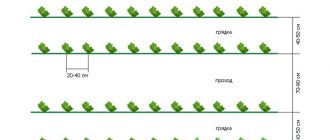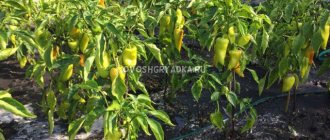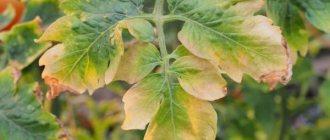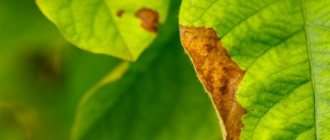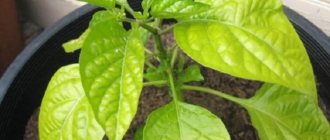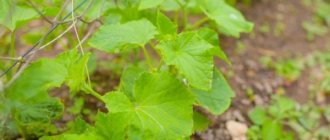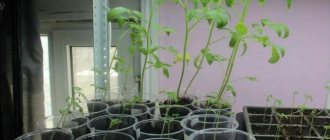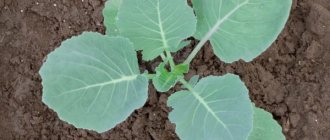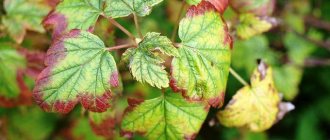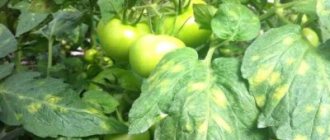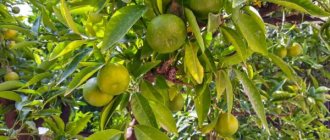Why do tomato leaves curl?
In most cases, the cause is errors in plant care. This happens especially often with beginning gardeners.
Tomato leaves may curl if the plant lacks moisture. This can be determined by the condition of the soil: normally it should be slightly moist.
The bright sun can also cause this phenomenon. Moisture evaporates from leaves when exposed to excessive heat. Watering in such a situation is useless, since the roots may begin to rot.
There is no need to put tomatoes in a dark place; It is important, however, to protect them from prolonged exposure to direct sunlight
Tomato seedlings (Photo used under standard license azbukaogorodnika.ru)
Air with too low humidity has a negative effect on seedlings. In addition, this often occurs in very hot rooms.
There may be a shortage of fertilizers and fertilizing. Excess will also not bring benefits; it can have a similar effect.
Sometimes seedlings outgrow the small container in which they were planted. Summer residents often place tomatoes in plastic cups, where the root system soon begins to run out of space.
Possible root damage. This can happen after a transplant.
Watering (Photo used under standard license azbukaogorodnika.ru)
The lack of pinching (removal of side shoots) can have a negative impact. The plant produces too many leaves, which often become curled.
Sometimes the cause is various pathologies and parasite infection. In such situations, special products are used, which can be purchased at gardening stores. Insecticides are selected depending on the type of parasite. In case of pathological processes, it is necessary to remove the affected leaves and treat the plant with special compounds, which, however, are not always effective: for example, bacterial cancer can be cured only in the early stages.
In addition, the phenomenon may be normal for some varieties. A similar feature of “Honey Drop” and most cherry tomatoes.
Illiterate pinching, pinching
Another common cause of leaf curling is improper pinching and pinching of bushes. It is unacceptable to remove all the lower leaves of tomatoes immediately after transplanting the seedlings into the greenhouse and in the next 20 days. Only after 3 weeks is it allowed to carry out this manipulation; this will improve the ventilation of the tomato bushes, lead to a decrease in humidity, and the plant will absorb more moisture, nutrients, and light. The result is improved development of ovaries and fruits.
Pinching must be done correctly. You can remove no more than two lower leaves per week. If you do not follow this rule, the plant will begin to hurt, weaken and wither.
In order not to harm the tomatoes, it is necessary to carry out pinching correctly. It is allowed to remove only side shoots whose length exceeds 10 centimeters.
Ash is an alternative to synthetic mineral fertilizers
Instead of ready-made mineral products, many vegetable growers add ash, which contains potassium, phosphorus and all the microelements plants need, and in an easily digestible form. The ash remaining after burning sunflower tops, straw, birch, pine, fruit trees, grass and shrubs is considered a worthy replacement for many mineral and microfertilizers.
The easiest way to feed, if you don’t know what to do when tomato leaves curl, is to water the plants at the root and spray them with an ash infusion from a spray bottle, which is prepared by diluting two glasses of sifted ash in 10 liters of water (leave for a day before pouring into Strain the sprayer; filtration is not required before watering the bushes).
Tomato leaves curl up
Sometimes growing a tomato crop requires a gardener to make enormous efforts. After all, the plant is attacked either by late blight or bacterial rot - there are many diseases, but they all need to be fought. It often happens that tomato leaves curl upward and this greatly affects the yield, which means it requires human intervention.
Why do tomato leaves curl upward in a greenhouse?
It has been noticed that greenhouse tomatoes are more susceptible to curling, unlike ground tomatoes. This happens due to the discrepancy between the temperature of the soil where the roots are located and the upper part of the plant, which is in the sun.
The tomato leaf curls up into a tube when the heat begins suddenly after cool or even cold weather. The soil does not have time to warm up, but the air in the greenhouse is already hot. To prevent the disease, in the summer it is necessary to regularly open the greenhouse, leaving cracks slightly open for through ventilation.
Rolling ground tomatoes
But not only greenhouse plants are susceptible to this disease. It often happens that tomato leaves curl upward and turn yellow even in open ground. This happens for various reasons, which are not always possible to find out.
The main culprit for curling tomato leaves is unstable air temperature. If it is quite cold at night and scorching heat during the day, then this has a very negative effect on the entire plant.
When daytime temperatures exceed 35°C, plants lose the ability to absorb nutrients from the soil, including from fertilizers. And those that were there earlier simply split and starvation of the plant occurs.
As you know, tomatoes love abundant but infrequent moisture; if watering is overused, the leaf plate can also curl - its edges wrap around the central vein of the leaf, and the leaf itself acquires a purple tint.
Abuse of pinching can sometimes lead to curling of the top leaves on tomato bushes, and therefore pinching should be done wisely and only at the beginning of the growing season, and not before the harvest ripens.
It has been noted that of all tomato varieties, tall varieties are most susceptible to leaf curl. Therefore, in order to guarantee the harvest of tomatoes on the site, you should plant not only them, but also low-growing varieties that are not so threatened by leaf curling.
But if you find that curled leaves begin to turn yellow, then this is a signal of a lack of microelements in the soil. Most often, plants are in intense need of phosphorus, zinc and iron, and then they will require feeding with a nutritional composition.
A good complex of essential microelements is provided by urea and slurry, which are applied between rows for uniform distribution between plants or bushes are added individually.
If the cause of leaf curl on tomatoes cannot be identified, and this happens quite often, then spraying the leaves with some biological products can help. So, in cool and humid weather, tomato bushes are treated with Epin solution from a spray bottle,
Why do the leaves of tomato seedlings curl upward?
If the leaves of small plants that have not yet been planted in the ground begin to curl upward, then the soil, which is poor in zinc and phosphorus, is definitely not suitable for them. To correct the situation, feeding with complex preparations with microelements will be required.
The leaves of seedlings can also curl from excess sun, and therefore on hot days it needs to be shaded. To avoid curling and burning the leaves.
womanadvice.ru
Damage to the root system
Often, immediately after planting seedlings in the ground, novice vegetable growers panic and run to look for the answer to the question: the leaves of tomatoes are curling and drooping, what should I do?
The first answer is not to worry. It often happens that during the process of transplanting, the roots of seedlings are damaged beyond measure and the plant is temporarily denied full access to the required amount of moisture and nutrition. This leads to the leaves of tomato seedlings drying out and curling, what should I do? Over time, when the tomato root system is restored, the negative manifestations disappear on their own.
If the condition drags on and causes you anxiety, you can add a small amount of complex fertilizers to the soil to help the plant recover faster.
Tomato diseases
Infections are another reason for changes in color, shape of leaf blades, and curling of tomato leaves. Diseases often arise due to improper agricultural practices:
- excessive watering;
- lack of ventilation for greenhouse plants;
- failure to maintain the distance between bushes when planting seedlings, thickened plantings in a greenhouse, in a garden bed, in a greenhouse;
- lack of stepsoning.
Bacterial cancer
With this dangerous disease, the leaf segments wither and curl slightly upward. Then they turn yellow and dry out. You can recognize that this is a bacterial cancer by the brown sores that appear on the petioles, stalks, and necrotic spots on tomatoes and stems.
The first signs appear on the lower tier, gradually the disease rises up and covers the entire plant.
Stolbur
Phytoplasmosis (stolbur) is a disease that is dangerous at any stage of tomato development. They are transmitted by leafhoppers and bugs, mainly from infected weeds.
On infected bushes, leaf blades turn yellow and become deformed. The edge of the leaves rises upward and acquires a violet-lilac or pinkish color. The shape of the leaf begins to resemble a “boat”. Stolbur affects the entire plant, including formed fruits. It is impossible to save diseased bushes, so they are removed from the ridge and burned.
Fusarium
With fusarium, the veins of the plant become discolored and the leaves below fall off. The leaf blades turn pale, curl, and the bush gradually withers and dies. When the stem is cut, brown vessels damaged by the pathogen are visible.
Verticillium
With such an infection, the plant usually does not die, but the summer resident cannot reap a full harvest. The lower tier of foliage turns yellow, chlorotic curling is observed at the top, leaf blades curl strongly and dry out.
The soil fungus clogs the blood vessels, causing tissue necrosis.
Tobacco mosaic virus
It is caused by one of the most contagious pathogens, transmitted by pests, and also on the hands of an infected plant (for example, when pinching). It manifests itself as a change in color and deformation of the leaves, wrinkling. The leaf plates curl and take on a bizarre fern-like or thread-like shape.
Bacteriosis
The first signs of infection are yellowing and curling of the leaves at the bottom of the stem. Brown stripes are visible on the shoots, “aerial” roots are formed, and mucus is released when the stem is cut.
Thin leaf virus
During the hot season, the crop develops a viral infection – thin leaves. Due to the heat and strong light inside the shelters, the tomato leaves curl into the thinnest tubes. Tomatoes set slowly, do not gain weight, and remain small with wrinkled skin.
Improper watering
Tomatoes are one of the most demanding crops when it comes to watering. The slightest lack of moisture or, on the contrary, excessively active watering leads to damage to the plant. The first symptom of improper watering is curling of the leaves.
If the leaves curl into a boat shape at the top of the head, this indicates a lack of moisture. When such a sign appears, it is unacceptable to fill the tomatoes with water to make up for its deficiency! You need to loosen the soil, water the soil thoroughly and cover it with mulch. This will prevent excessively rapid evaporation, but the humidity will not be too high. The tomatoes will receive sufficient nutrition.
When the soil moisture is high and watering is done too often, the leaves curl down. In addition, in this case, the root system suffers greatly, which can ultimately lead to damage to the bush.
Extreme temperatures
Tomatoes are a capricious crop. It is distinguished by its heat-loving nature. However, the heat also harms her. At temperatures above +35 ⁰C, curled leaves appear on tomato bushes. This is the first signal that the plants are starting to get sick due to uncomfortable living conditions.
At high temperatures in a greenhouse, it becomes difficult for a green organism to breathe. It begins to require increased doses of nutrients, the decay time of which is significantly reduced. In a hot environment, it is more difficult for tomatoes to absorb nutrition. This leads to deformation of the leaf plates on the bushes. They begin to twist along the vein running through the center.
An alarming symptom caused by exceeding the recommended temperature regime is observed only in the daytime, when the midday sun makes the greenhouse unbearably hot. As evening approaches, the temperature in the artificial shelter decreases, and the foliage begins to straighten, becoming toned.
To ensure that the crop does not suffer from extremely high temperatures during the day, it is necessary to take care of ventilation and take the following measures:
- ensure free circulation of air masses by opening the windows and doors;
- apply a layer of lime on the glass;
- resort to shading the bushes with lutrasil;
- mulch the ridges with straw or hay to protect the roots from overheating.
To help tomato bushes with foliage twisted from the heat recover faster, you can spray them with Epin.
Cotyledon leaves wither and fall off
Cotyledon leaves are the first 2 leaves that emerge from the germinal leaves during seed germination.
They have a lanceolate or narrow elliptical shape. Their purpose is to nourish the roots of the seedling. When 4-5 true leaves appear, the cotyledons begin to curl, wither and fall off. There is no need to panic. This is not a problem, not a disease, but a natural process. The cotyledons fulfilled their function and provided the seedling with nutrition in the first days of life. They are starting to get old. The functions of formation and accumulation of organic substances through photosynthesis begin to be performed by real leaves of seedlings.
Control of diseases and pests of seedlings
Some infectious diseases of seedlings, especially at the initial stage, manifest themselves in the form of leaf curling. Later, other signs of disease may be added, such as dried edges or the death of entire leaves. As a rule, infectious diseases are introduced by the gardener along with undisinfected tools or soil.
A disease such as bacteriosis is transmitted to plants through undisinfected seeds. The first sign of the disease is the leaves curling downwards, followed by yellowness of the leaves, stunted growth, and weak pigmentation. Such plants will not be able to form fruits at maturity and therefore must be discarded.
Fusarium or Fusarium wilt is a disease caused by a pathogenic soil fungus. Signs of the disease spread from the bottom of the plant to its upper edge. At the first symptoms of the disease, the infected sprout should be removed, the soil should be disinfected with a solution of potassium permanganate, and the tomatoes growing nearby should be treated with one of the biofungicides (fitoverm, actofite) 2-3 times with an interval of 7-10 days.
Alternaria blight, or dry brown spot, also causes plant leaves to curl, become mottled, and dry out. To combat the disease, tomatoes are sprayed with drugs that have an antifungal effect.
Leaves may also curl due to pest damage. Most often, tomato seedlings are affected by:
- tomato aphid;
- black aphid;
- mite;
- whitefly
To control pests of nightshade crops, bioinsecticides should be used.
Since most summer residents and gardeners grow seedlings at home, the most common pest is the common aphid, which affects most indoor plants. When this insect attacks tomatoes, the leaves also begin to curl. To combat a small amount of the pest, it is enough to spray the sprouts with aqueous solutions of garlic, ash or onion. In case of extensive damage, the use of chemical agents is recommended.
Infestation of seedlings by spider mites appears in the form of white or yellow puncture drops appearing on the leaves. Under the leaf plate a light web is visible to the naked eye. To combat the pest, it is enough to spray the plants with alcohol twice with an interval of seven days.
Curling of leaves is not always a sign of a disturbance in plant growth. However, if this appearance is not a feature of the variety, the possible reasons for their curling should be carefully analyzed and appropriate measures taken.
https://youtube.com/watch?v=VXRz5ICiOLI
Pest exposure
Often seedlings, even those grown at home, are attacked by pests. Aphids and spider mites can often be found on seedlings. These individuals are almost universal and infect the vast majority of crops grown through seedlings, and they can cause harm already in the early stages of development of seedling plants.
Since both aphids and spider mites are sucking pests, the first thing that can be noticed on the leaf blades is reddish spots at the puncture sites of the leaf, then the leaf loses turgor and curls. While aphids can be easily seen with the naked eye, spider mites are not so easy to spot; most often they live on the underside of the leaf.
Aphids on the leaves of tomato seedlings. © pinsdaddy
When you turn over the leaf blade, you can see a cobweb; these are traces of the vital activity of this pest. If it is detected, there is no doubt that the plant is infected with a bud mite. If the leaf blades of seedlings are severely damaged, in addition to leaf curling, they may completely turn yellow and fall off.
Prevention and control measures
Pests can not only cause leaf blades to curl, but also cause complete or partial death of seedlings, so they need to be dealt with very actively. When growing seedlings at home, it is undesirable to use “chemistry”; it is better to use folk remedies.
So, a tincture of onion peels can help fight aphids and spider mites, for which you need to pour a glass of onion peels with a liter of boiling water and let it brew for a day. Then the solution must be filtered and the plants treated with it every 3-4 days until the pests disappear.
You can additionally treat the soil, for which you need to prepare a pinkish, weak solution of potassium permanganate. Watering with such a solution should be carried out if treatment with onion peels does not produce results. The solution should be used carefully, no more than once a week.
Why do tomato seedlings curl their leaves?
Curling the first leaves of tomato seedlings is a natural process. Zoya, with our help, intends to find out: “Why do the leaves of tomato seedlings curl?”
The curling of the first embryonic leaves is a natural process: it should not bother you. Cotyledon leaves do not live long, giving way to permanent leaves.
Other causes of curling
Often this phenomenon occurs immediately after tomato seedlings “move” into open ground and only means that the plant is getting used to new conditions. After adaptation, the leaves will take the correct shape.
But you will have to think about the mistake made if time passes and the seedlings’ permanent leaves curl.
Often the leaves of tomato seedlings curl due to transplantation into open ground
Tender tops of seedlings can suffer from both a deficiency and an excess of water
In this regard, it is important for tomatoes to observe moderation. The hot rays of the sun are a likely reason for the curling of young leaves. Often, inexperienced gardeners place seedlings on the window sills of glass loggias, forgetting that the glass focuses the beam, forcing the leaves to resort to self-defense. Even with good watering of seedlings, the air in the room can be very dry and the leaves will also curl. If you forget to feed the soil, the plant will curl its leaves and most likely dry out. Excess fertilizer is also not good: if tomatoes are overfed with nitrogen, curling will develop in parallel with completely unnecessary growth of stepsons.
Tender tops of seedlings can suffer from both a deficiency and an excess of water
- In very rare cases, leaves curl due to a viral infection: the disease, as a catalyst for curling, is still more typical for adult tomatoes, when the curling of the tops is accompanied by yellowing and the appearance of spots.
- More often, the reason for curling is very banal - the roots of grown seedlings do not fit in small glasses and pots, where novice gardeners prefer to grow them.
You can also find out why the leaves dry on tomato seedlings by reading the corresponding article on our website.
Optimal conditions
We will assume that you have established the true reason for the curling of tomato foliage and, therefore, are ready to correct the situation.
Transplant tomato bushes into larger containers
- If seedlings require space, provide it by transferring them to the beds. Is it still cold outside? While waiting for warmer weather, transplant the bushes into larger containers.
- Don’t be overzealous when fertilizing the seedlings—it’s better not to feed them too much. A little ash will be enough for the tomatoes.
- Get rid of extra shoots, but don’t go too far: total destruction of the shoots will deprive the bush of its strength.
- In spring, the soil under the seedlings may be cold at elevated air temperatures, which means the roots do not have time to absorb moisture. If leaves curl for this reason, reduce soil moisture to warm it up.
- Tomato seedlings may simply freeze if spring is late outside the window. Then the plant also begins to slow down - it develops slowly, its leaves curl. To invigorate tomato bushes, spray them with epin (once every two weeks) or zircon.
- In case of sudden cold weather, cover the plants with non-woven material overnight.
- If the leaves curl from overheating, place a barrier in the form of newspaper between the tomatoes and the glass. You can move the seedlings away from the scorching rays of the sun, and get rid of dry air using a household humidifier.
Reasons for leaves curling on tomatoes (video)
If seedlings grow in a greenhouse, do not forget to ventilate it. If you follow these rules, the seedlings will not be capricious and will reward you with an excellent harvest of tomatoes.
DachaDecor.ru
What to do, how to help seedlings
If the leaves of tomato seedlings begin to curl, then first of all you need to pay attention to the frequency and abundance of watering, as well as the temperature in the room.
If the plants are watered correctly, and the temperature and lighting are optimal, then the reason is most often a lack or excess of nutrients. In this case, you need to start feeding the seedlings correctly. If the air in the room is excessively dry, then the foliage will need to be systematically moistened from a spray bottle with water at room temperature.
Tomatoes affected by a viral disease or tomato bacteriosis should be dug up and destroyed as soon as possible. For all remaining bushes, preventive treatment is carried out with a special preparation. If pests have settled on the bushes, then they should be sprayed with a solution of an insecticidal preparation.
If the leaves curl because the root system has become very crowded in the container in which the seedlings grow, then they can be helped in two ways:
- Firstly, the plant can be transplanted into a larger container.
- Secondly, it can be planted in a greenhouse, greenhouse or open ground. However, you should not delay this, otherwise the tomatoes may become very stretched and weakened.
Diseases caused by pathogenic microorganisms
Such diseases are the most dangerous for plant crops. Can be transmitted through soil, parasites or already present on tomato seeds. Bacteria can manifest themselves either immediately or remain in “sleeping” mode. To avoid plant diseases, you should not allow:
- Temperatures above 28 degrees Celsius.
- High soil moisture.
- Stagnation of water in planting pots.
Reference. To prevent bacterial diseases, do not neglect thorough disinfection of soil and seeds. Any copper-containing solution is suitable for treating seedlings.
The most dangerous bacterial disease can be considered “bacterial cancer”. The disease destroys the vessels of the plant. Externally it appears as:
- The appearance of ulcers along the entire stem trunk.
- Complete death of seedlings.
Treatment is impossible. The diseased plant must be removed and burned. The soil in which the seedlings were located is no longer used. This disease can be prevented by treating seeds with 40 percent formaldehyde (calculating 1 part solution - 300 parts water).
spotting
Buraya
This disease has the following symptoms:
- Small yellow spots on the outside of the leaves.
- Rapid growth of these spots.
- White coating on the inside of the leaf.
- Dying of seedling leaves.
The disease can be cured by spraying cuprosil, copper sulfate or any other copper-containing drug.
Black bacterial
External symptoms of the disease appear quite late:
- Slight lethargy of the sprout.
- Small black spots on the leaves and stem of the tomato.
- Rapid spread of spots throughout the plant.
- Death of a seedling.
It is better to remove infected seedlings. The remaining sprouts must be treated with 1 percent Bordeaux solution every few days.
Mottling
The disease develops due to the penetration of phytopathogenic bacteria into the crop. External signs of the disease:
- The appearance of transparent oil stains on the leaves of seedlings.
- Leaf damage begins from the edges to the middle.
- Curling of plant foliage.
- Complete loss of leaves.
To cure seedlings, it is necessary to spray with copper sulfate (calculating 1 glass - 10 liters of water) or Fitolavin-300.
Stolbur
The most common bacterial disease of home seedlings. The disease is caused by microplasma bodies that are carried by many types of insects. Symptoms of the disease:
- Pink or purple spots on seedlings.
- The leaves and trunk of the plant become very rough.
Treatment and prevention are carried out with any special drug:
- Confidor.
- Aktara.
- Mospilan.
Spraying is carried out twice:
- Three weeks after planting the seeds in the container.
- Before planting seedlings in a permanent place.
Bacterial wilt
A dangerous disease when plants suddenly begin to wither. Other symptoms may include:
- Formation of aerial roots.
- Stopping plant growth.
- Covering the leaves of seedlings with yellow spots.
- Formation of longitudinal brown stripes on the stem.
The disease is incurable. The seedlings should be burned and the soil cultivated. Other plants need to be disinfected with Fitoflavin-300.
The photo below shows a plant affected by the disease:
To get a large harvest of tomatoes in the fall, you need to properly maintain the seedlings in winter. If you care for your seedlings responsibly, you can avoid many diseases.
Preventive measures
Proper agricultural technology and careful attention to the choice of soil and seeds will avoid many problems in the further cultivation of seedlings.
Basic recommendations for preventing curling of pepper leaves can be summarized as follows:
- Soil for seedlings, for prevention, is placed inside the stove and calcined, treated with potassium permanganate or poured with boiling water. This will destroy the eggs and larvae of pests.
- Containers for seedlings and tools are treated with alcohol or another disinfectant solution.
- Seed material is purchased from trusted suppliers. When purchasing seeds from your own hands, there is no guarantee that there will be no fungal or bacterial infections.
- You should choose disease-resistant pepper varieties.
- Compliance with the required temperature and humidity conditions will avoid many problems when growing seedlings.
If you follow these simple rules, you can get strong and healthy seedlings. And this is the key to the full development of an adult plant, a guarantee of a bountiful harvest of bell pepper.
Reasons for tomato tops curling
You have damaged the roots
If you recently planted tomato seedlings and their leaves have changed, it is possible that you have damaged part of the root system. Therefore, the plant does not receive enough nutrition.
Wait a while for the tomato to adapt. When the bush takes root and restores all damage, the leaves will most likely return to their normal shape.
It's too hot outside or in the greenhouse
If the weather is hot, the plant tries to reduce the amount of moisture that evaporates through the tops, which is why the leaves curl.
Watch the tomatoes. If the tops have changed their shape for this reason, then in the evening the leaves will unfold in order to be saturated with moisture in the evening and restore the water balance.
If the air temperature in the greenhouse is above +35 degrees, then most likely the leaves will curl.
You rarely water or overwater your tomatoes.
Also, tomato tops can curl if you don’t have time to care for the garden, you forget about watering, or you water the bushes incorrectly, wetting only 3-5 cm of soil.
Due to lack of moisture, the leaf blades of tomatoes begin to curl with their edges up, forming a “boat”.
Lack or excess of microelements in the soil
Often, tomato leaves begin to curl if you forgot to fertilize in a timely manner or if you “overfed” the plants. Due to an excess of microelements, such as nitrogen, tomato leaves may begin to curl inward and dry out.
Garden pests
Tomatoes, which are forced to grow in a greenhouse, especially suffer from garden parasites. Spider mites, whiteflies, and aphids take away all the juices, which is why the tops turn yellow, and later the leaves curl into a tube.
You did the stepson incorrectly
This procedure is carried out only when the tomato shoots grow to 5-7 cm. Remember, you cannot immediately remove too much greenery, as this is a serious stressful situation for tomatoes. Carry out the procedure correctly, do not get carried away.
Diseases
Sometimes tomato diseases are to blame for everything, which are not always possible to cope with:
- Bacteriosis. Tomato bushes grow poorly, they have short shoots, and the flowers are very small.
- Thin leaf virus. It appears rarely, only if there has been a long drought, and the greenhouse is too light.
- Bacterial cancer. The leaves of the tomatoes curl up, then they wither, turn brown and dry out. Cracks are visible on the stems.
- Tobacco mosaic virus. A pattern resembling a mosaic appears on the tops; swellings are visible.
- Fusarium. First, it makes itself felt on the lower leaves, gradually moving to the top, and over time the tops fall off completely. Then the upper shoots of the bush begin to wither, and a light or pinkish coating may appear on the fruits - tomatoes.
- Verticillium wilt. Its symptoms are similar to fusarium, only this disease does not destroy the plants.
Excess or lack of fertilizers
You can’t get a good tomato harvest without fertilizers, many people know this, but some, for fear of harming the plants, apply too little of them, while others, wanting to get the maximum yield, apply too much of them. Both of these lead to curling of tomato leaf blades.
So, when there is an excess of zinc in the soil, the edges of the tomato leaf blade begin to bend. This can be confused with similar symptoms with a lack or excess of moisture, however, with an excess of zinc in the soil, the lower part of the tomato plants becomes purple in color, which is not typical for these plants.
When there is an excess of manganese in the soil, tomato leaves first curl, and then wrinkle and become bright green.
When there is an excess of nitrogen in the soil, the leaf blades of plants begin to curl, usually at the top of the plant. To neutralize the effects of nitrogen, you need to add potassium sulfate (8-10 g per square meter) or wood ash (50-80 g for each plant) to the soil in advance loosened and watered.
When there is a lack of elements, for example, calcium, tomato foliage begins to curl upward; this state of the leaf blades is often accompanied by the appearance of blossom end rot on the fruit. If excess zinc and manganese is quite difficult to eliminate, then calcium deficiency can be easily dealt with by adding calcium nitrate to the soil. To do this, you need to dissolve approximately 18-22 g of calcium nitrate in a bucket of water, adding 350-400 g of wood ash and 8-12 g of urea to the solution. This solution is enough for 3-4 square meters of soil under tomatoes.
With a lack of phosphorus, tomato leaves also curl, but at the same time become grayish. In order to quickly restore the flow of phosphorus into the plants, you need to add an aqueous solution to the soil, diluting 80-90 g of superphosphate in a bucket of water, this is the norm for 3-4 square meters of beds occupied by tomatoes.
With a copper deficiency, tomato leaf blades, in addition to curling, also acquire an atypical yellow color, sometimes becoming covered with yellowish spots, which may subsequently begin to turn black. Treatment with copper-containing preparations – “HOM”, “Oxyx” and the like will help restore the balance of copper.
Blue or curling tomato leaves may indicate a lack of phosphorus. Michelle
Lack of nutrients in the soil
Curling leaves may indicate that the plant is not adequately receiving some micronutrient. In most cases, tomatoes do not have enough phosphorus, boron, iron or potassium.
- If the plant needs phosphorus, then the tomato leaves are curled up in a boat at a right angle from the stem. At the same time, they acquire a dark green or purple hue.
- If tomatoes need an element such as potassium, then the tomato leaves curl up in a boat from the middle of the leaf, and characteristic light spots will appear on the fruits.
- If there is a lack of iron in tomatoes, in addition to curling, the leaves become weak, begin to wither, turn yellow and fall off over time.
- If a plant lacks boron, then only young leaves begin to curl and change color.
You can help get nutrients for tomatoes by feeding them. If you are one of those gardeners who are opponents of chemicals, then in this case you can use wood ash as a top dressing. Potassium nitrate or superphosphate are used as mineral fertilizers and fertilizing.
The main causes of leaf curling
Healthy seedlings are quickly accepted in the greenhouse and take root in the open garden bed. Young tomato bushes wither at too high a temperature, which is why they lack moisture, and the roots do not absorb mineral components well. It is not always possible to immediately determine why the leaves curl.
Violation of agricultural technology during cultivation
Only by finding out the reason for the wilting of the seedlings can you save it and wait for the tomatoes to ripen. Most often, young tomatoes die when care rules are ignored and agricultural practices are violated.
The leaves change color and bend down:
- in insufficient lighting;
- due to temperature changes;
- when placing seedlings in acidic soil.
When sowing tomato seeds in heavy clay soil, seedlings do not appear for a long time, the roots of the seedlings develop poorly, since air and nutritional components are difficult to reach them. Salts are formed in the soil, absorbing microelements.
To prevent the seedlings from dying, they are transplanted into a new substrate made from peat and leaf soil with the addition of sand and vermiculite. The soil is disinfected or placed in a hot oven for 30 minutes.
Excess of mineral fertilizers
Seedlings develop normally when they have enough nutritional components. However, when overfeeding with nitrogen:
- The stems become denser.
- The roots are damaged.
- The leaves curl.
If there is an excess of substance in the substrate, the top layer of soil is removed, and new soil is added, combined with sawdust. After watering, the seedlings are placed and treated with Epin.
Nutritional deficiencies
When tomato shoots appear in a greenhouse in which the temperature is maintained high, the leaves on them curl. This phenomenon is observed due to the fact that plants lack fresh air, making it difficult to absorb nutrients.
Lack of microelements
The development of tomatoes slows down, and seedlings die when there is not enough boron, nitrogen, and potassium. With a deficiency of magnesium, light spots form between the veins, which over time become brown, the leaves curl and dry out.
Lack of phosphorus negatively affects the condition of the roots; the above-ground part of young tomatoes becomes purple in color, becomes hard, and the edges of the leaves dry out. Their necrosis occurs due to a lack of potassium. With a deficiency of this microelement, the stem withers.
Bronze spots across the entire surface of the plate appear when seedlings lack zinc.
Improper watering
When the soil dries out, which occurs with irregular irrigation, the absorption of nutrients is impaired, and the leaves of the tomatoes in the greenhouse begin to wither.
With frequent and abundant watering, water stagnates in the soil, which can lead to:
- rotting of roots;
- activation of fungi;
- death of seedlings.
If there is excess moisture, the bushes are removed from the wet substrate, moved to another soil treated with a solution of potassium permanganate, and the leaves are sprayed with a growth stimulator.
Damage to the root system
Tomato seedlings wither; when they grow up, the box becomes crowded. In this case, the bushes are removed and dumped into another container, but sometimes the root or stem is damaged during replanting. The plant dies.
Varietal trait
Some tomatoes have very thin leaves; they curl downwards along the entire length of the plate, which does not increase in size as quickly as the vein grows. In hybrid varieties Japanese crab, Fatima, miniature cherry tomatoes and tall tomatoes, this phenomenon is considered the norm, and does not pose a danger to the development of seedlings.
Ambient temperature too high
Tomatoes stop absorbing the necessary components when they are cold, at 14 they are not saturated with phosphorus, and at 10 they do not absorb nitrogen. But at temperatures exceeding 35, the leaves of the seedlings turn inward due to overheating. Seedlings develop normally at 20–23 degrees.
How to avoid curling
It is not enough to know the reasons why the leaves of tomato seedlings curl. It is important to be able to prevent deviation. Preventive measures are as follows:
Treating seeds before sowing
- Treating containers for planting with disinfectant solutions. Often, gardeners use a medium concentration manganese solution.
- Proper soil preparation. Purchased or prepared substrate is spilled with Fitosporin or potassium permanganate. It is also important to add sand, ash and vermiculite to the soil. With the help of these components, the soil mixture will be light and loose, which is positive for the development of seedlings.
- Treating seeds before sowing. For the procedure, a strong solution of potassium permanganate, fungicides and alcohol-based preparations are used.
- Using a disinfected tool when picking seedlings.
- Compliance with the recommended temperature regime at different stages of seedling development.
- Organization of good drainage and systematic watering. Stagnation of water will provoke root rot, and insufficient moisture disrupts the development of the root system.
- Use of nutritional supplements at the specified times and in the recommended quantities. An excess of minerals also has a detrimental effect on seedlings, as does their deficiency.
The health of seedlings is influenced by many factors. To get strong, viable seedlings, you need to gain experience and be patient. Providing proper care and compliance with cultivation requirements will avoid most problems with tomatoes. If curling does begin, treatment should be started immediately, otherwise the risk of crop loss increases.
